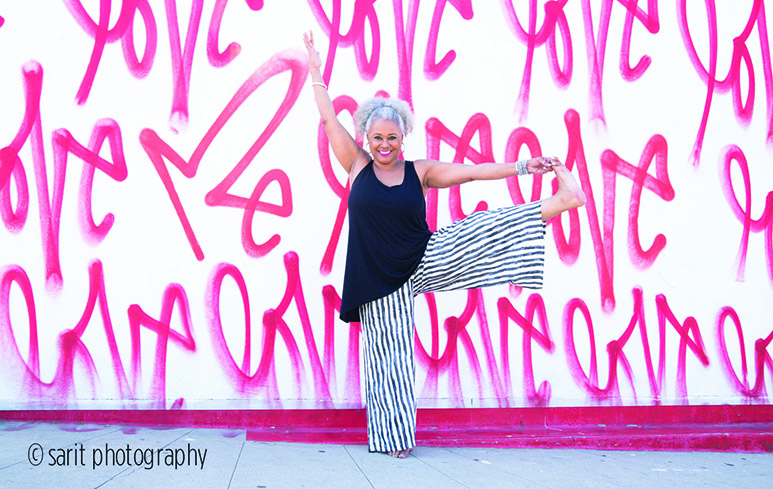
Accessible Yoga Teacher De Jur photographed by Sarit Rogers for Love More Movement.
7 Lessons from the first Accessible Yoga Conference
“The invisibility of disability” is often used as term to describe people whose challenges are not necessarily visible; for example, they may not be walking with a cane nor are they rolling in a wheelchair. This phrase can also describe how people at large view those who are noticeably “differently abled”—they may feel invisible or be unseen by others.
As the practice of yoga becomes more widespread, as the evidence grows for the positive benefit of yoga practice, the need for yoga teachers to be more inclusive is a growing area of discussion. The first annual Accessible Yoga Conference was a flurry of excitement with a combination of ancient practices and new beginnings. Conference founder Jivana Heyman is the co-owner of the Santa Barbara Yoga Center, director of the Integral Yoga Institute San Francisco, and an Integral Yoga Minister. He is committed to the practice of making yoga accessible to anyone who wants to pursue it.
Here are some of the lessons we learned to inform teaching and practice.
Anything can be a yoga prop.
The conference nurtured my ability to think outside of the box in terms of how to use props. For example, a phone book (yes, they’re still around) or other thick book can support the knees in supta baddha konasana. Try looking around the house for everyday resources to augment practice.
Someone in a wheelchair may want to practice on the floor.
While chair yoga is an amazing practice, sometimes we all want to play on the floor. Teacher JoAnn Lyons uses yoga mats in creative ways to help students transfer safely from a chair to the floor.
Read 6 Ways to Create Classes for People of All Ability Levels.
Respect everyone’s space.
Just as we may step aside to avoid trampling on someone’s yoga mat, a wheelchair is someone’s personal space, and an unattended chair is not an invitation for a joyride.
Anyone who is well-trained can teach yoga.
Sometimes we assume that people must be able-bodied or even perfect to teach yoga. At the conference, I learned from a variety of differently-abled people who are exemplary yoga teachers. I also realized that anyone who is well-trained and has embodied the practice—no matter if they have a visible or invisible disability—can teach this practice.
Kindness is an invitation for all students to attend class.
I awakened my awareness around welcoming all students. It’s important to make sure that this invitation is not done with pomp and circumstance but with kindness and friendliness. Everyone deserves to receive the same excitement and gratitude when they enter my class. I have been the “other” in a class: the only black woman and the only older woman. Inclusivity includes everyone, be they people of color, round, curvy, differently abled, or LGBTQ.
Inclusive language matters.
One of the coolest things I took away was a cache of thoughtful, verbal cues to add to my teaching arsenal–language to normalize the adaptive nature of any practice. For example, Dianne Bondy, of Yoga For All and the Yoga and Body Image Coalition, spoke about not using gender identifiers (he/she) and using “they” instead.
Every body can do yoga—with modifications.
Dianne Bondy shared a series of brilliant modifications for larger bodies. One that stood out was her modified plow, where she uses the wall behind the body for support and a strap to keep the breasts at bay. (Trust me, those of us with larger breasts appreciate this!) There is grace in allowing someone to modify and modulate their practice. On occasion I have a student in my class who is an amputee or significantly injured (some of my students have bullets in their bodies or knife punctures). What may be “different” to me is “normal” to someone else and vise versa. That was an important takeaway: understanding that we are all whole and complete and enough as we are.
Differently abled people are so often invisible and marginalized in ways able-bodied people cannot fathom and the beautiful and healing practice of yoga is something that brings us together, and is of benefit to all. Yoga has enabled me personally to cope with work stress and to remain grounded and balanced and focused in my life. I feel beautiful and walk through life with deep passion and vigor. It’s my practice that has fueled this self-love and keeps me young at heart. We can all be part of this love and strive to make yoga even more accessible to all who wish to practice.
Thanks to Sarit Rogers for her assistance with this article.
For more information about the Accessible Yoga movement, visit: accessibleyoga.org.
The 2016 Accessible Yoga Conference will be held at the Santa Barbara Yoga Center, September 16-18.
